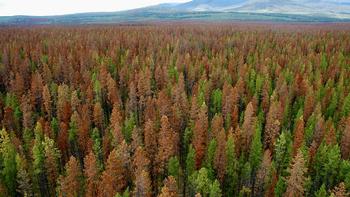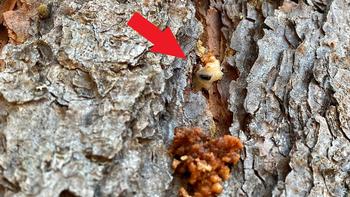Pine bark beetle
-
Martha Proctor
-
Trees, especially pine trees, are in for challenging times! Although pine trees are relatively drought-tolerant, ongoing drought, as we’ve experienced in Marin County for several years, has caused stress in many pine trees due to the lack of water. Signs of stress in beetle-infested trees include thinning, having a slightly yellowish canopy, or roots that spider across a lawn. If the drought and stress are prolonged and the trees begin turning brown, the trees will die unless some precautionary measures are taken before that point is reached. Unfortunately, not much can be done to stop an infestation once the beetles are in a tree.
 Forest damaged by Pine Bark Beetle. Photo: Matthew Brown, University of Washington
Forest damaged by Pine Bark Beetle. Photo: Matthew Brown, University of WashingtonPlants and trees cannot survive without water. With the water inside a plant’s cells, many critical metabolic processes occur, e.g., photosynthesis and the transport of mineral nutrients. In addition, several metabolites are responsible for many of the defense mechanisms a plant needs to thwart infectious diseases and certain insect attacks. As the severity of drought persists, those protective metabolites decrease, and plants become vulnerable to secondary attacks by certain insects and diseases.
The most common culprit attacking stressed pine trees in urban landscapes in California is the pine bark beetle. Bark beetles are dark, cylindrical insects that can fly from tree to tree. Most species are smaller than a grain of rice. The most common pine bark beetle species in California’s lower elevations are the engraver beetle, the red turpentine beetle, and the western pine beetle. Bark beetles injure trees by disrupting the flow of nutrients.
When the population of bark beetles is small, the beetles attack the most stressed trees. If beetle populations grow and drought conditions continue, the beetles can attack in numbers large enough to overwhelm a tree’s defenses. In large numbers, they can attack and kill healthier trees. When the number of beetles is low to moderate, healthy trees fight back by filling their holes/tunnels with white to tan-colored sap. Severely stressed trees cannot fight back and may produce little or no sap.
A successful beetle attack is typically marked by small, pinkish volcano-shaped pitch tubes or small excreted bits of coarse, boring dust, or frass, trapped in bark fissures and piled at the base of the tree. Peel back the bark on infested trees to view tunnels caused by an adult and/or larval mining. If the fresh sap is deep-red around the tunnels, this is the sign of a more serious infestation. Pitch tubes from Western Pine beetle attack on a Ponderosa pine. Photo: Chris Lee, CalFire
Pitch tubes from Western Pine beetle attack on a Ponderosa pine. Photo: Chris Lee, CalFireAs a precautionary measure, regularly inspect your pine trees for signs of boring dust, small holes exuding sap, and tree crown decline. Thinning out weak, diseased, beetle-infested trees helps reduce competition for water among the remaining trees. Avoid compacting soil and injuring roots and trunks. Consider removing heavily infested trees while they are still green. Most bark beetles will already have emerged once a tree turns red. Destroy infested material by chipping or solarizing debris to prevent emerging beetles from attacking healthy trees.
If a drought-stressed tree is of high value, irrigate it by placing a soaker hose inside the dripline in late spring or early summer. Cover the soaker hose with mulch and run the hose until the soil is moist to a depth of 12 inches. Wait until the upper 12 inches of soil is dry before irrigating again. Sap production requires water, so beetles are more likely to succeed in a drought-stressed tree. Insecticides won’t save heavily infested trees because they have a limited impact on bark beetles once they are inside the tree. If you have a special tree you want to try to save, contact a licensed applicator as that is the only source for an effective bark beetle insecticide. If deemed necessary, prophylactic applications of insecticides to the bark surface can protect high-value trees from bark beetle attacks.


